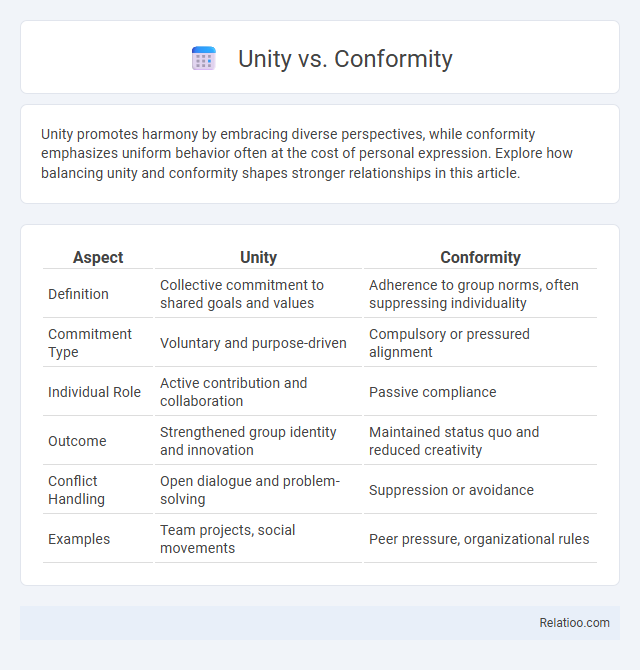Unity promotes harmony by embracing diverse perspectives, while conformity emphasizes uniform behavior often at the cost of personal expression. Explore how balancing unity and conformity shapes stronger relationships in this article.
Table of Comparison
| Aspect | Unity | Conformity |
|---|---|---|
| Definition | Collective commitment to shared goals and values | Adherence to group norms, often suppressing individuality |
| Commitment Type | Voluntary and purpose-driven | Compulsory or pressured alignment |
| Individual Role | Active contribution and collaboration | Passive compliance |
| Outcome | Strengthened group identity and innovation | Maintained status quo and reduced creativity |
| Conflict Handling | Open dialogue and problem-solving | Suppression or avoidance |
| Examples | Team projects, social movements | Peer pressure, organizational rules |
Understanding the Concepts: Unity vs Conformity
Unity emphasizes collaboration and shared purpose among diverse individuals, fostering creativity and collective strength. Conformity involves individuals aligning their behaviors and beliefs to match group norms, often at the expense of personal uniqueness. Understanding the balance between unity and conformity is essential for cultivating environments where cooperation thrives without suppressing individual expression.
Historical Perspectives on Unity and Conformity
Historical perspectives on unity and conformity reveal shifting priorities across cultures and eras, with ancient societies often valuing conformity as a means of social order and cohesion, such as in Confucian China or Roman law systems. The Enlightenment period challenged blind conformity by promoting individual reason and unity based on shared principles rather than uniform behavior. Modern democratic societies emphasize unity through diversity, balancing collective identity with personal freedoms to avoid the pitfalls of total conformity seen in authoritarian regimes.
Psychological Foundations of Group Dynamics
Unity fosters a strong sense of belonging and collective identity, enhancing group cohesion and motivation through shared goals and mutual support. Conformity influences individuals to align behaviors with group norms, driven by social approval and fear of rejection, which helps maintain order but can suppress individuality. Understanding these dynamics allows your group to balance individuality and togetherness, optimizing cooperation and psychological well-being within any social structure.
The Role of Unity in Social Progress
Unity fosters collective strength and inclusivity, enabling diverse groups to collaborate effectively toward shared social goals. It stimulates innovation and resilience by integrating varied perspectives, which drives meaningful societal reforms and enhances community well-being. Social progress thrives when unity bridges differences, creating an environment conducive to empathy, cooperation, and sustainable development.
Conformity: Benefits and Drawbacks
Conformity enhances social cohesion by promoting uniform behavior and facilitating group harmony, which can lead to increased predictability and cooperation in communities or workplaces. However, excessive conformity suppresses individuality, stifles creativity, and may perpetuate outdated or unethical norms, limiting innovation and personal growth. Balancing conformity with unity allows groups to maintain order while embracing diverse perspectives that drive progress.
Unity in the Workplace: Collaboration vs Compliance
Unity in the workplace enhances collaboration by fostering open communication, trust, and shared goals, which drives innovation and productivity. Unlike conformity, which emphasizes compliance with rigid rules and suppresses individuality, unity encourages diverse perspectives and mutual respect. This collaborative unity creates a dynamic environment where employees feel valued, motivated, and empowered to contribute their unique skills.
Cultural Influences on Unity and Conformity
Cultural influences significantly shape how unity and conformity are perceived and enacted within societies, with collectivist cultures often valuing unity as a shared identity and social harmony, while individualistic cultures may prioritize conformity through adherence to social norms for personal autonomy. Your understanding of unity becomes enriched when recognizing that cultural contexts dictate whether conformity fosters group cohesion or suppresses individuality. Analyzing these cultural dynamics provides insight into how communal values and societal expectations influence social behavior and collective cooperation.
Fostering Healthy Unity Without Enforcing Conformity
Fostering healthy unity without enforcing conformity requires embracing diversity and encouraging open dialogue, allowing Your team to maintain individual perspectives while working toward common goals. Unity thrives when collaboration respects personal differences, promoting innovation and mutual respect instead of suppressing unique ideas to force uniformity. Balancing collective purpose with personal authenticity ensures a cohesive environment where inclusivity and shared values coexist effectively.
Case Studies: Unity Versus Conformity in Practice
Case studies highlight how organizations balancing unity and conformity optimize collaboration while fostering innovation. Companies like Google encourage diversity of thought within a unified culture, promoting adaptability and employee empowerment without demanding strict conformity. Your understanding of these practices can guide implementing flexible frameworks that maintain cohesion yet embrace individuality.
Striking the Balance: Achieving Unity While Respecting Individuality
Striking the balance between unity and conformity requires fostering a cohesive environment that values diverse perspectives without suppressing individuality. Emphasizing collaboration and open communication helps you build a culture where collective goals align with personal expression. Prioritizing mutual respect and flexibility ensures that unity enhances rather than diminishes the unique strengths of every member.

Infographic: Unity vs Conformity
 relatioo.com
relatioo.com